There
were, of course, many creatures in the sea.
Unfortunately, I didn't have an underwater camera
and so have no shots of the reef or the fish,
moray eels, sea snakes, etc., from below the
surface. Fortunately, some loyal members of
the PPDRDG have managed to smuggle out photos of
several species especially for this expose.
My thanks to Beckie for the dolphin, blue fish,
and sea turd photos.
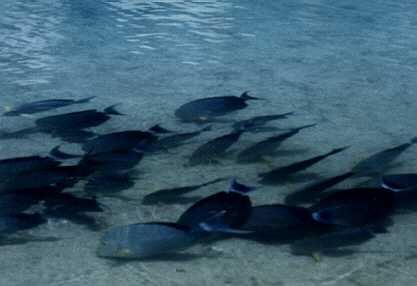
However, just walking along the coral lips of the
barachois, or on the beach revealed many interesting
sights. Sea Turtles were quite common, with
Hawksbills being in the lagoon year round. They
could be found at high tide up inside the various
barachois, feeding on the algae that lived on the
coral shelves. There were also Greens
seasonally, and they laid eggs on the southwest
beaches on the ocean-side. On several occasions
I found new nests (which I did not open!) and many
hatched nests, with the leathery eggs "shells" all
over the place, and little tracks leading down to the
water, just like on a Jacques Costeau TV
show. Unfortunately, I never saw the event
itself. In holes in the coral, you could also
see shrimp larva, waiting to become bait. Below
are photos I took of a hawksbill, a stingray, what we
called martian crabs ("Spider Crabs" found on the
ocean side), some shrimp larva in a hole at low tide
in Turtle Cove, and another of Beckie's photos of
dolphins. The last is of a young sand shark at
Shark's Cove.
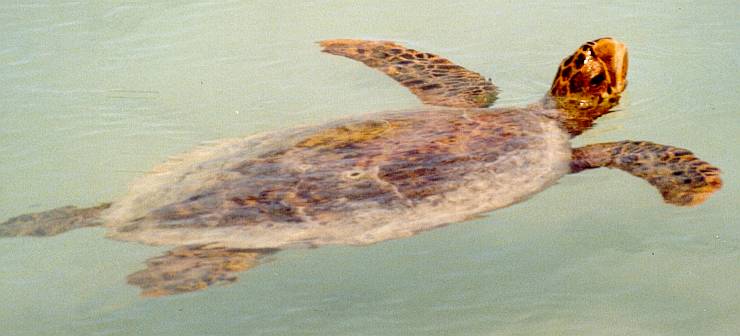 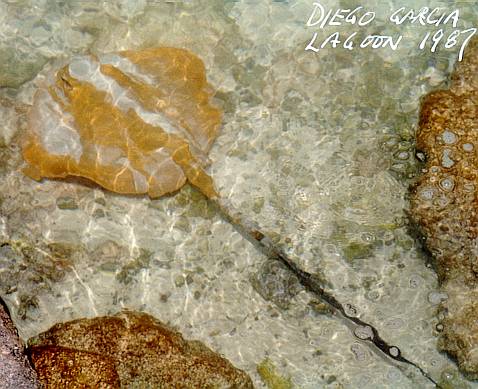 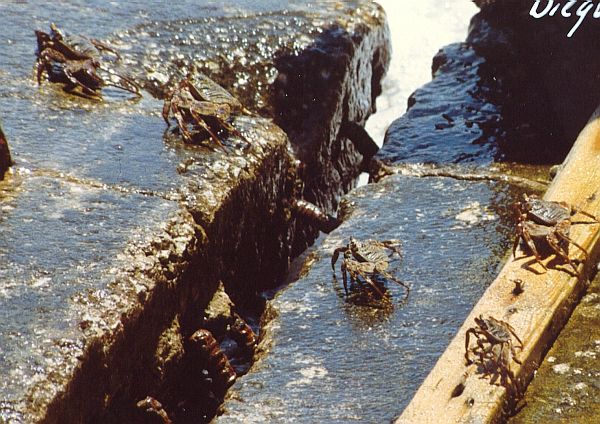
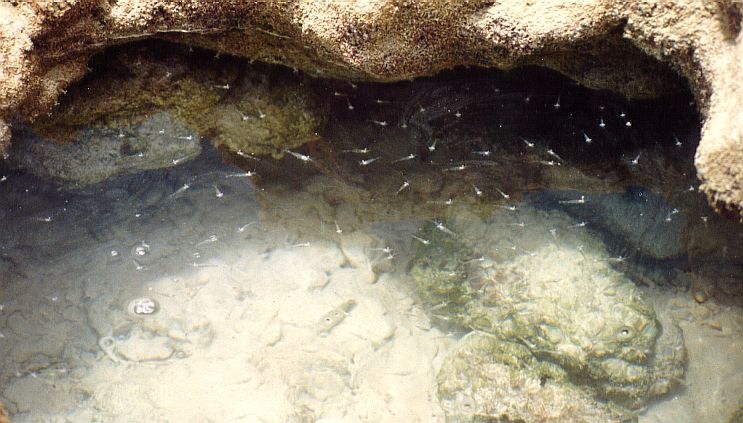 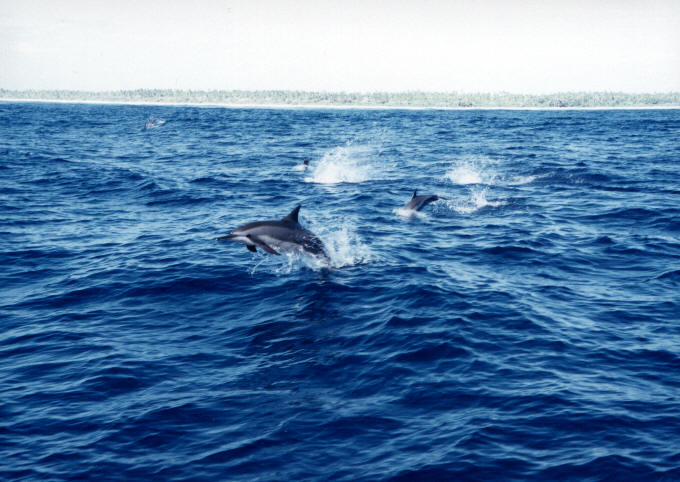 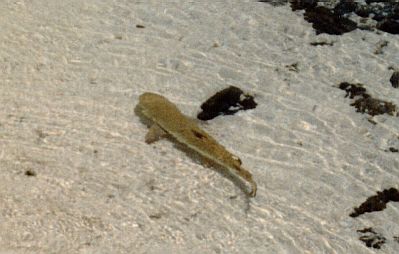
Here's Steve Swayne's picture
of a school of mullet in 1982:
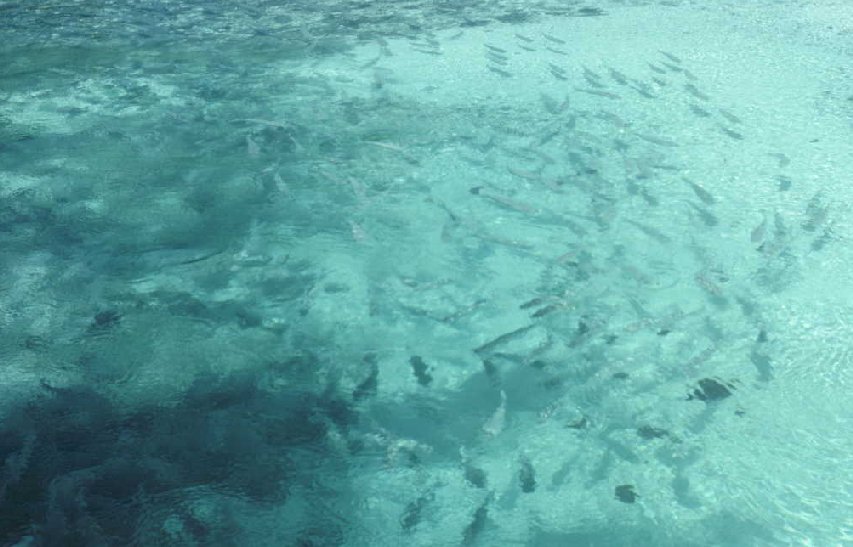 . .

Here
is one of the species of Clownfish (Amphiprion
chagosensis) that is ONLY found in the Chagos
Islands. If you've seen one while
snorkeling, you are indeed lucky to have seen a
unique and rare sight indeed! Thanks to Kurt
Rosenbaum for the picture.
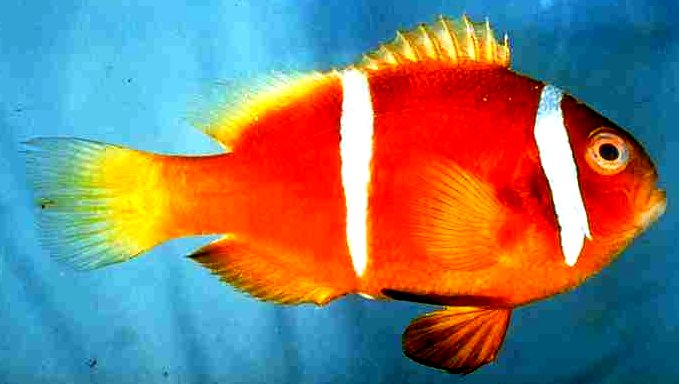

One
of the main uses for the sea creatures of DG was
as squeeze toys. The photos below, also from
Beckie, are of what she calls Sea Turds, and I
can't figure a better name (although they are most
often called Sea Cucumbers). They are the
squishiest, slimiest things in the sea, and we
used to eat them all the time in Korea. But
I just couldn't get anybody interested out there
on Dodge, fortunately, because today the lagoon at
DG is the only safe haven for these disgusting
creatures! Read
all
about the Sri Lankan Sea Cucumber Poachers
who prowl the Chagos looking for giant snot rolls
to eat!
 

The most
popular uses of sea creatures was for picnics.
Here is
the way many Diego Garcians remember the
preparations!
Mmmmmm,
tuna steaks 2" thick!

Also, it is a
little known fact that Diego's own Tuna Hunter
Lagoon was once the home to tens of thousands
of "Tropical Beluga Whales". Now, just a
few are left, and confined for their own
safety in the pool next to the outdoor theater
downtown. Only the dedicated efforts of
Green Peace have brought these shy creatures
back from the edge of extinction.
Unfortunately.
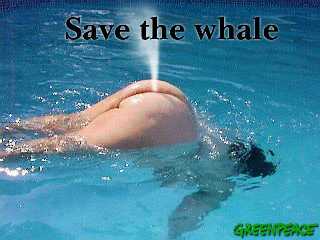

Special Bonus Article: How to
Poach Lobsters,
by "Commandante Uno" of the PPDRDG
Liberation Army
As we all know, lobsters abound in
the waters around DG, but catching them is not
permitted by the current ocuppying capitalist
running dog powers. So, we, the freedom
fighters of the movement, had to be extremely
careful whenever we were breaking the
law...er...that is, demanding our rights!
Here's how we did it.
First,
the best lobstering grounds are at the south end
of the island, on the ocean side, down near
T-Site and GEODSS. The lobsters come up
from the depths onto the reef at night
to feed on all the flotsam and jetsome that
floats around. They travel from one place
to another along little sand highways between
the coral heads. Just sort of walk along,
sometimes several dozen wandering along, playing
follow the leader.
Now,
in the glow of a flashlight, a crab's eyes glow
silver, but a lobster's glow
golden, just like tiny nuggets.
However, since the water over the reef was
usually 6 or 8 feet deep, with the breakers
coming in, it was normally not possible to
witness this remarkable difference between
competing crustacians. But when there was
no moon, and therefore a low tide, the water
over the reef was only calf deep, and smooth,
except for a gentle undertow. It was then
that the freedom fighters of the PPDRDG would go
out onto the reef, shine our flashlights into
the water along the little sand trails and see
for ourselves the golden eye gleam. It was
perhaps 300 yards out to the edge of the reef,
and there were plenty of those little sand
highways all the way out. You could get
out within a dozen yards of the breakers which
just pounded on the outer reef, and which would
gently wash over your knees on the way in, and
produce that gentle sucking undertow tug on the
way back out.
Sometimes,
members of our glorious Liberation Army would be
so enchanted with the golden eye effect while
out there on that reef, that they would reach
into the water and grab the lobster by the
carapace and bring him up above the surface to
see the effect more closely. The lobsters
would always bark at this removal from their
notcturnal ramblings. They would slap
there tails against their bellies two or three
times and bark just like a little chihuahua dog
(also a favored food of Liberation Armies
everywhere). This would so amaze the
person holding the lobster that the first time
it happened to one, one usually dropped the
lobster back into the water, and it would
quickly swim away, backwards. But after
the first time, the barking was so remarkable,
that the freedom fighter would often put the
lobster in a string bag or old pillow case he
might have with him, to take the lobster and any
others he might find, back to the beach to show
his comrades.
The
only problem with this was that sometimes, there
might be a member of the oppresive overseer's
police forces nearby, and the punishment for
bring up even one small lobster to show one's
friends would be fines of $500 U.S. and even
time in a jail in Hong Kong or someplace equally
crowded. So, the revolutionary forces came
up with special surveillance plans to prevent
such an unfortunate discovery.
First,
we would liberate some FM hand-held portable
radios from someplace where they might be left
unattended. Then, one of our mates would
pull the unhappy duty of waiting by the Donkey
Gate with one of the liberated radios.
Then another would be on the beach where the
lobster-lookers were. This radioman or
woman would also have an air horn of the kind
used for emergency signalling from a boat in
distress, or to rattle the teeth of the people
in the next row at a basketball game whenever
your team would score a 3-pointer. Should
the Donkey Gateman or woman notice a vehicle
heading for the southern tip of the island, they
would relay the call to the Beachman or woman,
who would give a long blast on the air horn, and
the men or women hundreds of yards out on the
reef would turn off their flashlights and wait,
as motionless as possible, for the all clear
(two long blasts of the air horn).
Not
every one of my comrades were comfortable with
this arrangement. In addition to lobsters
in the knee deep water there were also many
moray eels and sea snakes cruising the reef at
night. And the spiny star fish would be
slithering all over too. It was unnerving
to some, but not to me of course, to have things
constantly brushing against your ankles and
poking hairy little tentacles down between your
toes there in the dark. And it was
dark. I mean, really really dark.
Dark as the pit. Real dark. Of
course, that didn't ever bother me.
And
then, wouldn't you know it, the tide would start
coming in, and the water would get to your knees
and then to your thighs, and still no double
blast on the horn because the idiot you left on
the beach dropped it when he went to hide
himself in the scaviola and then lost his
flashlight too and even though the Brit police
had driven away a half an hour before this bozo
still can't let those of us on the reef know it
because there's no moon and he can't find the
airhorn and is afraid to feel around for it
because he's heard that sea snakes crawl up on
the beach at night even though they don't but he
believes it and so is just standing there on the
beach and its really really really dark and the
water is getting deep enough to start that
undertow tugging one foot or the other off the
little coral head your standing on and then
finally el stupido on the beach realizes he can
honk the truck horn twice and that will work and
the flashlights pop on immediately a couple
hundred yards on either side of you and you
count them and know no body has gotten sucked
out to sea yet and you start walking back in to
the beach and all the way you swear your going
to personnally strangle the idiot who left you
out there in the really really really black
night surrounded by that really really really
black water full of stingrays and lion fish and
cone shells and those little bitty jellyfish the
Aussies call sea wasps that will leave a welt
for a week but you never even saw it because it
was so fucking dark out there and finally you
get to where there's no more water, and you pick
your way across the coral up to the beach line
and all of a sudden the rock you made your next
step onto moves and its one of those really big
sea turtles and it flops it flippers and looks
at you with those big black eyes and heads on
down the beach but not to lay eggs just to find
a pool to stay wet in until the tide comes in
and the tide in coming in and then you realize
you've still got a dozen lobsters in your
pillowcase and you decide you won't go back out
into the surf to let them go and everyone else
has a dozen or so and your lobsters aren't so
interesting anymore in fact the golden eye
effect doesn't work out the the water and you
get kinda angry and decide you'll show those
lobsters and you put them in the ice chest with
the ice but first you get out that bottle of San
Magoo beer and then a cigarette and take a long
drag and a swish the beer around in your mouth
before you swallow it and blow out the smoke
through your nose and say to your
comrades: "Well, we cheated death
again. Whadda ya say we take these
lobsters back to my room and boil them and eat
them and drink somemore beer?"
And
this is what the we mean when we say the life of
freedom fighter for the Provisional People's
Democratic Republic of Diego Garcia is the best
life there is.
And
that's the way you poach the Queen's Lobsters on
Diego Garcia. The End.
Commandante
Uno
PPDRDG
Liberation Army.
|

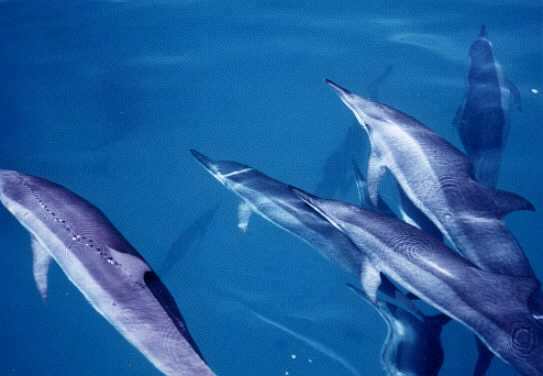



 .
. 



